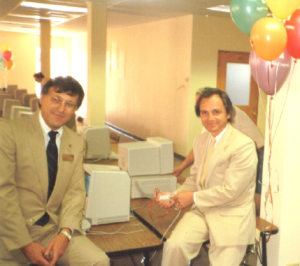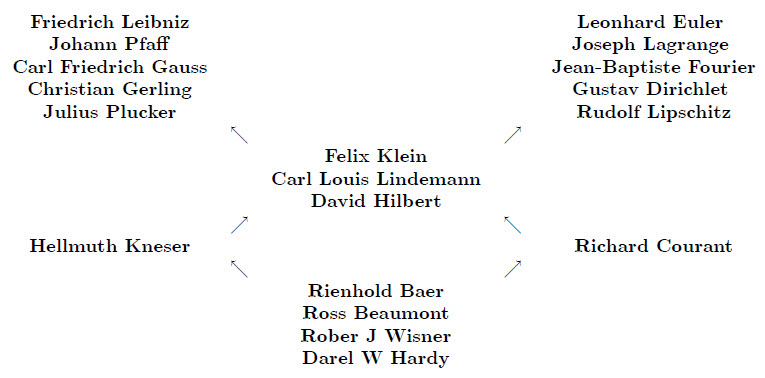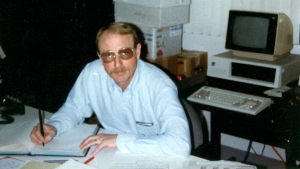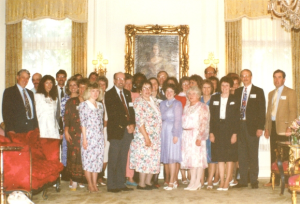4In January of 1967 I attended the Joint Mathematics Meetings in Houston, looking for a job. There I interviewed with Arne Magnus from Colorado State University in Fort Collins, and shortly thereafter I accepted their offer, starting as an Assistant Professor of Mathematics. As I look back on my life and career, I realize how very fortunate I have been. There was a chart years later at one of the joint mathematics meetings that showed the ratio of applicants per opening during each year for mathematics positions at universities and colleges in the United States. The year 1967 was clearly the best year in the later half of the 20th century to find a job in mathematics. They say location is everything, but timing is good too.
My career has been spent almost entirely at Colorado State University in Fort Collins. The year 1967 was a good year to look for a job in mathematics, and indeed the CSU Mathematics Department added seven faculty members that year, including five assistant professors.
My first few years at Colorado State were focused on teaching courses ranging from calculus to abstract algebra and doing research in the theory of semigroups. I gave occasional talks at local high schools and at regional and national mathematics meetings.
In 1970 my first PhD student was Marian Brown, whose dissertation was Generalizations of Inverse Semigroups. Richard Painter served as a co-adviser.
In 1972 Robert Brandon became my second PhD student. His dissertation title was Algebraic and Combinatorial Properties of the Semigroup of binary Relations. He was later the department head in mathematics at Eastern Oregon University College in La Grande.
My third Phd student was Yupaporn Tirasupa, who wrote Semilattices of P-Semigroups in 1975. As of this writing in 2012, she is still a active faculty member at Chulalongkorn University in Bangkok, Thailand.
Through my major professor Bob Wisner at NMSU, I became intrigued by the CRICISAM project. Bob was an editor for Brooks/Cole and was also involved in CRICISAM, which proposed the idea of introducing integration before differentiation. Bob and Jack Thornton, the president of Brooks/Cole, visited Fort Collins and convinced me to sign a contract to write a book on calculus, using the CRICISAM approach. I had be experimenting with the use of calculators by students, and it seemed to me that calculators could make the integration-first approach work.
The book Basic Calculus was published in 1975. It included material for a two-semester course in single-variable calculus, with integration followed by differentiation. My comfort zone has always been on the bleeding edge. As soon as something is established, I’m ready to move on to something else. Unfortunately, the comfort zone for rest of the world is not on the bleeding edge. The book did reasonably well in Canada, but didn’t create much excitement in the United States.
In 1976 I was the invited luncheon speaker at Northeastern Junior College Science Day, an annual day of competition for junior high and high school mathematics and science students. Back in Fort Collins, I proposed the idea of a high school math contest. The first thought was to do a small-scale experiment with local Fort Collins schools. Looking more closely at the work involved in organizing such an event and creating numerous oral and written questions, I decided that we might as well sink or swim and invite schools from throughout the state of Colorado. I became the originator and first director of CSU Math Day.
In November of 1977 we hosted our first CSU Math Day with roughly 500 students from 50 schools. We had the written PROBE exam, a College-Bowl style team tournament with three-member teams, and a short answer quiz called Quickies. For several years, my high school physics and mathematics teacher Philip Good brought a team all the way from Montrose. The CSU Math Day held in November of 2012 used much fancier buzzers for the team competition, but the whole operation felt remarkably similar to that first CSU Math Day in 1977.
During the spring of 1979 I was a Visiting Associate Professor at the University of Nebraska. The word ‘spring’ is a bit misleading. I was climatized to the dry winters in Colorado and New Mexico. I had never been so cold in all my life as I was in January in Lincoln.
Departments of mathematics tend to develop groups of several mathematicians in a narrow specialized area, as a means of gaining national and international reputations. NMSU was the world’s most active site in the theory of infinite abelian groups while I was a student there. When I visited the University of Nebraska, the department was the world’s most active site in the theory of algebraic semigroups. In addition to John Meakin, Don Miller, and Mel Thornton, were the visitors Francis Pastijn and myself. Five may not sound like a very large number, but in the theory of algebraic semigroups, five is huge. My visit reinvigorated my research career, and I wrote joint papers with both Mel Thornton and Francis Pastijn. Thanks to Francis Pastijn, my Erdös number is ≤ 3.
Don Miller became a Visiting Professor at Colorado State University a couple of years later, and was instrumental in establishing a math day at Nebraska, based on what he saw at CSU.
At the secondary level, personal computers were introduces first into mathematics classrooms. Duane Clow and I helped support this initiative by creating the first computer lab on campus. We removed hoods, sinks, and equipment from an abandoned chemistry lab on the second floor, west wing of the Weber Building and filled it with Apple II computers purchased through a grant in the College of Engineering.
About this time I wrote a BASIC program that ran on an Apple II that allowed the Department of Mathematics to keep track in real time of schedule changes of students adding and dropping mathematics courses during the schedule change period. Other departments were keeping hand-written lists of students who requested a class in those departments. We were on the bleeding edge of technology.
 As funding slightly improved for student computing, I became the director of the College of Natural Sciences Macintosh lab in 1987. This lab was located in the same general area where Duane and I had created the first computer lab. During that remodel, workers wore hazmat suits because of the existing asbestos in the walls. Duane and I had decided to do a quick remodel, then ask for forgiveness later. The lab changed over the years, and Jean-Louis Gassee visited that grand opening of the College of Natural Sciences Macintosh Lab.
As funding slightly improved for student computing, I became the director of the College of Natural Sciences Macintosh lab in 1987. This lab was located in the same general area where Duane and I had created the first computer lab. During that remodel, workers wore hazmat suits because of the existing asbestos in the walls. Duane and I had decided to do a quick remodel, then ask for forgiveness later. The lab changed over the years, and Jean-Louis Gassee visited that grand opening of the College of Natural Sciences Macintosh Lab.
In 1989 I became the Colorado Director of the Western Mathematics Scholars Program. The director of this five-state program was Don Miller of the University of Nebraska. This program was designed to create mathematics teacher leaders who could then inspire others in their schools to improve mathematics teaching and learning. The most exciting part of this program was the opportunity to work with teachers such as Marilyn Stor and Barbara Pond, who were former recipients of the Colorado Outstanding Mathematics Teacher award.
In November of 1990 I was the keynote speaker at the Eight Annual Conference of the Rocky Mountain Association of Computers in Education. The title of the talk was Scientific Visualization.
The Tulane Conference in January of 1986 kicked of the calculus reform movement. In the spring of 1992 I returned to NMSU as a Visiting Professor to observe what they were doing in their calculus project. I taught one of their experimental calculus sections that stressed student writing with instructors as observers and not lecturers in the classroom. Skills were tested using computer-generated problems that were hand graded and could be repeated until successful.
I returned to CSU as the coordinator of first-semester calculus. My team of calculus instructors were all graduate teaching assistants, who follow suggested guidelines much better than fellow faculty members. We had automated skills testing and tried to follow many of the suggestions made by people around the country who were a part of the calculus reform movement.
Lynne Ipiña of the University of Wyoming and I organized the Rocky Mountain Calculus Conference, which was held at CSU on April 5, 1994. Guest speakers included James Stewart, Brooks/Cole author; Roland Larson, representing Project CALC at Duke University; Ed Dubinsky, representing the Purdue Project; Arnold Ostebee, representing the St. Olaf Project; and Karen Thrash, representing the Harvard Consortium Calculus Project.
At the January 1994 Joint Mathematics Meetings in Cincinnati I decided to trade my Macintosh in on a PC. Carol Walker had agreed to write documentation for the computational part of Scientific WorkPlace. This software was being developed in Las Cruces by the company T3, led by Roger Hunter, a former member of the NMSU Mathematics Department. Carol had taken a new position in the dean’s office and didn’t have enough time to do all of the writing. Since I had a background in Maple, which was to be the computer algebra component of SWP, I was a likely candidate to help write the new documentation.
I had taught an overload in the fall and had a reduced spring schedule, so I agreed to coauthor the documentation. We were working with very preliminary versions of the software, so we didn’t have a clear picture of how the computations would look. John Thomas, another former faculty member from NMSU, was writing the hooks that would connect Maple to SWP. We would ask how he planned to implement certain things and he would answer, “How should it be done? You write the documentation and I will program it to work that way.”
We wrote the documentation, went through two rounds of reviews, and the book Doing Mathematics with Scientific WorkPlace went to press in the summer, a month or two before the release of SWP.
In the fall of 1995 I started working on the Colorado Integrated Mathematics Initiative, together with Glenn Bruckhart and Fred Stein, Director of the Center for Science, Mathematics, and Technology Education at Colorado State University. This program was funded by the Gates Foundation and held during part of the summer at Pingree Park on the CSU forestry campus. Our schedule with the high school mathematics teachers was four hours of classroom time in the morning, a four-hour hike, then more classroom time in the evening. The hikes may actually have been the most productive hours of the day, with informal chats and time to ponder what was going on in the classroom component.
In 1997 Carol and I wrote a paperback book, Doing Calculus with Scientific Notebook, published by Brooks/Cole, the new owner of Scientific Notebook and Scientific WorkPlace. Brooks/Cole expected to incorporate Scientific Notebook into a supplement for Calculus by James Stewart. Carol and I worked on this supplement, but it never became a part of Stewart’s book. Brooks/Cole seemed to know very little about how to market software, and used Scientific Notebook mostly as a freebee to help promote their line of books. They managed to nearly ruin Scientific Notebook and Scientific WorkPlace.
To the rescue came Barry MacKichan, another former member of the mathematics faculty and NMSU who had also worked for Microsoft during its glory years. He had retired from Microsoft with enough money to purchase the struggling SN and SWP product lines. Looking for a name for the new company, he noted that the name MacKichan Software had not been taken. In the year 2000, a revised Doing Mathematics With Scientific WorkPlace and Scientific Notebook was in print.
At Colorado State, we had a course called Applied Algebra, but at the time nobody knew what the content of such a course should be. Bob Liebler suggested that the content should be a combination of codes and ciphers. An error-control code is designed to correct errors in a message that may have been transmitted through a noisy channel. A cipher is intended to make a message appear to be random bits of nonsense to anyone trying to listen in, but that will make perfect sense to the intended recipient, who possesses the proper secret keys.
I took Bob’s suggestion and wrote classroom notes, which I taught several times. In 2003 these notes were expanded into Applied Algebra: Codes, Ciphers, and Discrete Algorithms with the help of Carol and published by Prentice Hall. This book was translated into Japanese in 2005. The translation continues to sell better than the English version. Unfortunately, the royalty is paid at a much lower rate.
In 2006 Carol and I enlisted the help of Fred Richman and Bob Wisner to write our first ebook, using Scientific Notebook as the browser. This book, Calculus: Understanding Its Concepts and Methods, was published by MacKichan Software. I used several rough drafts of this book before retiring from CSU.
After my retirement became official in the spring of 2004, I did one encore at CSU, teaching a large lecture section of third-semester calculus. This gave me one more chance to work with the nice material in multivariable calculus and develop more three-dimensional plots and animations using Scientific Notebook.
In 2008 we self-published three more ebooks Precalculus, Calculus for Advanced Placement, and Business Calculus. Diane Davis, CSU Ph.D. and Metropolitan State University of Denver faculty member was added to the list of authors for Business Calculus. A second edition of Applied Algebra: Codes, Ciphers, and Discrete Algorithms, with third author Fred Richman, was published in 2008 by CRC Press.
In December of 2008, I gave an invited talk, Animations That Help Students Construct Knowledge in Mathematics at the Asian Technology Conference in Mathematics in Bangkok, Thailand.
In April of 2010, I gave a talk Some Average Calculus Problems at the Southwestern Section Meeting of the Mathematical Association of America in Scottsdale, Arizona, and again at the Rocky Mountain Section Meeting in Fort Collins.
I also picked a great collection of mathematical ancestors, as the following chart illustrates.



